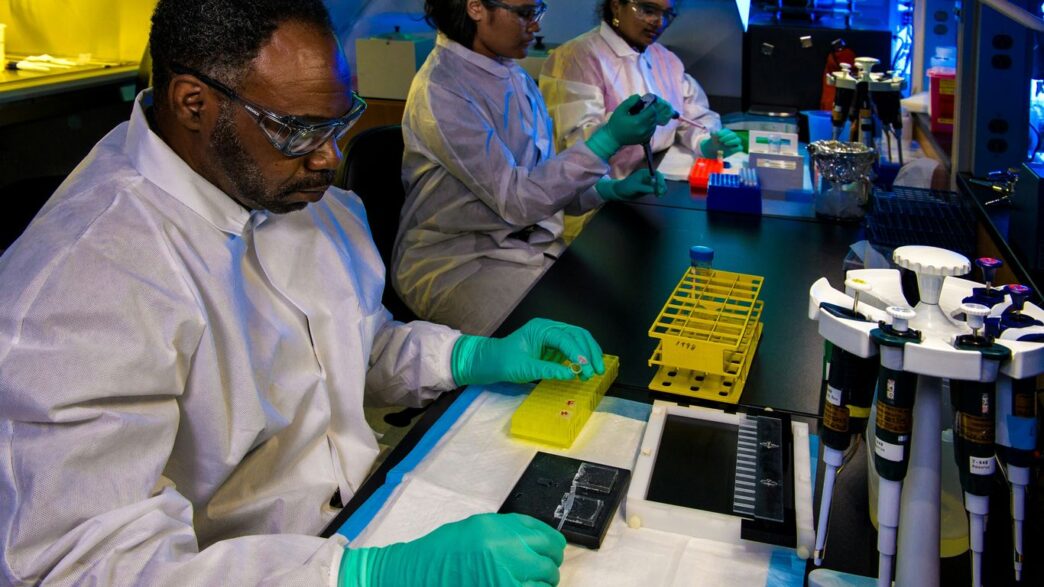The biotech industry has seen some wild swings lately. After a huge surge in 2024, everyone’s watching to see what happens next. Numbers are big: the global biotech market hit $1.55 trillion in 2024 and could reach $4.61 trillion by 2034. North America alone made up over $520 billion in 2023. With all this activity, there’s a lot of excitement and a bit of uncertainty. Companies are betting on new tech, like AI for drug discovery and better gene editing tools, but they’re also dealing with tougher rules and more competition. If you’re working in biotech or just curious about where things are headed, here’s a look at what’s shaping the industry for 2025 and beyond.
Key Takeaways
- The biotech market is expected to keep growing fast, with new technologies pushing the pace.
- AI and gene editing are leading the way in drug discovery and treatment options.
- Investors are more selective now, focusing on companies with strong science and clear benefits.
- Companies are teaming up more with research partners to handle complex trials and regulations.
- Jobs in biotech are expanding, especially for people with skills in new tech and personalized medicine.
Current Landscape of the Biotech Industry
The biotech world has changed a lot in just a few years. From huge investment frenzies to market resets, the industry feels very different in 2025 compared to the boom days of 2021. Let’s break down where biotech stands today, what regions are on the rise, and how companies are shifting their focus.
Global Market Size and Forecasts
The biotech sector isn’t just big—it’s growing at an almost staggering pace. In 2024, the global biotech market hit about $1.55 trillion. If you look out ten years, projections say it could reach an eye-watering $4.61 trillion by 2034. North America is currently leading the charge with a market size of $521 billion in 2023, but other regions are catching up quickly.
Here’s a quick table summarizing the numbers:
| Year | Global Market Size ($ Trillion) | North America ($ Billion) |
|---|---|---|
| 2023 | 1.37 | 521.0 |
| 2024 | 1.55 | – |
| 2034 (est.) | 4.61 | – |
This growth isn’t just about therapies. It includes diagnostics, farming tech, industrial enzymes, and digital health—basically, all the places where biology meets practical tech.
Regional Growth Hotspots
Some regions are outpacing others:
- North America: Still the leader, thanks to a combo of strong research universities, venture funding, and government support.
- Europe: Gaining steam with regulatory reforms and growing venture activity, especially in biotech hubs like the UK, Switzerland, and Germany.
- Asia-Pacific: Watching China, Japan, and South Korea, where local investment is translating into more home-grown biotech start-ups and partnerships with big multinational companies.
That said, the gap between regions is getting smaller as knowledge and investment flow more freely across borders.
Shifting Industry Priorities
The days of “grow at all costs” are over. Biotech companies are now under pressure to show clear benefits to patients, scientifically solid projects, and a realistic path to getting paid for their products. Here’s what’s shaping priorities now:
- Companies are investing more cautiously—funding still exists, but only for companies with strong, validated science.
- Contract research organizations (CROs) are doing more than just outsourced experiments—they’re acting as partners in everything from regulatory strategy to commercial planning.
- Investors are focusing on innovations that stand out, like cell and gene therapies, rather than following trends.
These shifts mean biotech is likely to keep growing, but the road ahead looks less speculative and a lot more strategic than it did a few years ago.
Biotech Market Analysis: Emerging Technologies Shaping 2025
It’s hard to keep up these days, honestly. 2025 is shaping up to be all about using better tech to find answers faster in biotech. If you’re looking for what’s new and what’s actually changing labs or boardrooms, here’s what keeps showing up when people talk about the near future.
Artificial Intelligence in Drug Discovery
Everyone’s buzzing about AI right now—because it’s not hype anymore. Companies are using AI to scan big datasets and spot patterns humans would probably miss. This is pushing drug discovery timelines down, sometimes turning a process that used to take years into something that can be done in months.
Key uses of AI in drug research:
- Predicting which molecules are likely to make good drugs
- Flagging potential side effects early on
- Optimizing clinical trial designs based on historic trends and real-time patient data
Here’s a quick table showing benefits companies reported after adopting AI-driven platforms in 2024:
| Benefit | % Reporting Improvement |
|---|---|
| Faster candidate selection | 63% |
| Lower research costs | 52% |
| Greater trial accuracy | 47% |
Looking for more on how AI, along with other new technologies, is making waves? See recent technology market research news.
Advances in Genome Sequencing
Genome sequencing is getting a major upgrade. Just a few years ago, only the best-funded labs could afford to sequence a single human genome. In 2025, we’re seeing costs drop thanks to rapid software progress and smarter DNA assembly methods.
Big impacts from new sequencing tech:
- Disease genetics are mapped quicker, guiding drug development
- More patients get access to rare disease testing
- Researchers piece together complex diseases (like cancer) using bigger, better datasets
Companies like Illumina and Roche are leading the way, rolling out sequencing gear that’s faster and more accurate every year. The real game changer? Hospitals using whole-genome data for routine patient screens.
Impact of CRISPR and Gene Editing
CRISPR tools seem like science fiction, but now trials for things like sickle cell and cystic fibrosis are actually underway. Gene editing is expected to broaden out—so it isn’t just about rare diseases, but common ones and maybe even high-efficiency crops.
Recent moves in CRISPR/gene editing:
- Early treatments for blood disorders and rare pediatric genetic conditions
- Promising research targeting cancer mutations directly
- Major agricultural trials for drought-resistant crops
Biotech’s future isn’t just high hopes anymore—tools like CRISPR are already impacting real lives and opening brand new doors.
Overall, 2025 is lining up to be a year where new technologies finally shake up how treatments are discovered, tested, and delivered.
Investment and Funding Trends in Biotech Market Analysis
Venture Capital and IPO Activity
If you think the biotech boom of 2021 set the stage for massive, unfettered growth, you’d be partly right—but only for a while. Back then, early-stage companies and new technologies reeled in record cash: global biotech startups netted over $70 billion in venture funding, while U.S. biotech IPOs pulled together roughly $14 billion. Fast-forward to 2022–2023 and things shifted—hard. Funding plunged 35-40% from those highs, a slide driven mostly by inflation concerns and global economic jitters.
Now, in 2025, the world is seeing a cautious recovery. There’s money on the table, but investors aren’t spraying it everywhere. They want evidence: compelling data, a clear clinical pathway, and a shot at regulatory approval. Oncology, advanced gene therapies, and anything with a strong biomarker to anchor its claims gets the most attention.
Here’s a look at how funding has changed (all figures in $USD, billions):
| Year | Global VC Funding | US Biotech IPOs |
|---|---|---|
| 2021 | 70.9 | 14 |
| 2022 | ~45 | ~6 |
| 2024 | 55+ | ~10 |
Shifting Investor Expectations
The days of ‘growth at any cost’ in biotech are over. Investors now put their bets on fewer, more matured programs. There are clear themes:
- Programs need solid science, not just hype.
- Regulatory pathways must be realistic—not just wishful thinking.
- Commercial potential is more closely scrutinized, especially for rare or niche diseases.
- Companies with data in hand—whether from early clinical trials or validated biomarkers—move to the front of the line.
Basically, it’s not enough to have a cool idea. Investors are looking for execution, proof, and a roadmap to actual revenue within a believable timeline.
Implications for Early-Stage Companies
For startups, the shift has been a wake-up call. Raising money as a new biotech company now means adapting fast:
- Lean operations are necessary. Investors want to see that teams can do more with less.
- Clinical development plans must be focused and cost-efficient, avoiding overly complex or risky study designs.
- Team strength counts more—proven track records, experienced scientific founders, and credible advisors stand out.
- Partnership is on the rise: Early-stage biotechs often work closer with big pharma or integrated CROs to both prove and fund their pipelines.
All of this means the quality bar is much higher, but for those who clear it, there’s still real money to be had. The funding reality in 2025 is less about hype and more about substance—if your science hits that sweet spot, there’s opportunity.
Strategic Shifts in Biotech Research and Development

Over the past few years, biotech R&D has felt some big changes. After the wild funding surge in 2021 and the sudden correction just a year later, it’s not business as usual anymore.
Integrated CRO Partnerships
Companies used to just outsource single jobs to different contract research organizations (CROs). Now, many biotech firms are looking for CROs that can walk with them from the first experiment all the way to market launch. These newer partnerships don’t just save time—the big plus is making the whole process less of a shuffle between different teams and more of a coordinated effort.
Some benefits of integrated partnerships:
- Consistent communication across clinical, regulatory, and commercial phases
- Simplified processes (fewer hand-offs, less confusion)
- More focus on patient needs and timelines
Here’s a quick table showing the shift in CRO engagement models:
| Year | % Using Integrated CROs | % Using Multiple Single-Service CROs |
|---|---|---|
| 2022 | 38% | 62% |
| 2025* | 58% | 42% |
| *(est.) |
Optimizing Clinical Trial Design
It takes ages to get a drug through the pipeline. Clinical trials are still long and expensive, but the approach is changing. More companies are using tech like digital twins (virtual patient models) and smarter predictive tools. They’re:
- Running smaller, targeted trials with biomarkers for faster results.
- Using real-world data earlier in the process.
- Adapting studies as new results come in, instead of waiting until the end.
This means less wasted money and more chances of finding something that really works for patients.
R&D Portfolio Strategies
When money was pouring in, companies tried to develop a bunch of different things at once. After the funding cool-down, though, that’s changing fast. Now, most firms are trimming their pipelines, putting more attention on high-potential projects.
How companies make these hard choices:
- Look at clinical evidence—if early results aren’t promising, projects get cut.
- Assess alignment—some programs just don’t fit with long-term goals anymore.
- Consider market trends—opportunities in crowded or low-profit areas may no longer make sense.
Typical portfolio actions now include:
- Scaling back in rare or oversaturated disease areas
- Doubling down on promising platforms with strong data
- Looking for smarter partnerships (including possible mergers)
Biotech R&D’s new chapter is all about doing less, but doing it smarter. The winners are usually the teams that focus, plan early, and aren’t afraid to make tough calls about where to put their resources.
Innovation and Growth in Advanced Therapeutics
Therapies that once sounded futuristic—cell therapy, gene therapy, and personalized medicine—are now front and center. These aren’t only lab wins: doctors and patients are actually seeing real, positive changes as these treatments hit the market. Still, there’s a lot happening behind the scenes. Let’s break down what’s shaping this area today.
Cell and Gene Therapy Expansion
Cell and gene therapies have moved past their original small niches. Back in the day, most approvals hit blood cancers like leukemia and lymphoma. Recently though, new treatments are tackling solid tumors—a challenge scientists struggled with for years.
The numbers in this area speak for themselves:
| Year | New Cell & Gene Therapy Approvals | Projected Market Size (US$B) |
|---|---|---|
| 2023 | 7 | 51.8 |
| 2024 | 9 | 62.5 |
| 2025* | 13 (projected) | 74.2 |
*Estimates for 2025
Three things are pushing this trend:
- Faster regulatory pathways for high-need drugs.
- Expanding treatment to more cancer types, not just for rare diseases.
- Growing investment: pharma giants want a piece of these lower-risk, high-potential breakthroughs.
Regenerative Medicine Developments
Regenerative medicine is catching up in clinics, not just academic papers. This field aims to actually repair or replace damaged tissues using living cells or biomaterials. Some of the most promising waves are:
- Stem cell therapies for spinal cord injuries, diabetes, and heart disease.
- Bioprinting—literally printing new tissue structures for use in surgery or research.
- Next-gen scaffolds that help the body heal after injury or major surgery.
Progress is steady, but it takes time. Clinical trial pipelines are filling up as more companies see commercial potential—and as insurance and regulatory hurdles become clearer.
Personalized Medicine Initiatives
Personalized medicine is no longer just a buzzword. Instead of one-size-fits-all drugs, treatments now get matched to genetic markers, lifestyle, or even microbiome differences. Here’s what’s driving this shift:
- Affordable genome sequencing: It’s faster and cheaper, letting more doctors use DNA to guide care.
- Better biomarkers: These are blood or tissue readouts that predict which drug will work (or not work) for you.
- Patient demand: People want more targeted therapies, especially as expectations rise from success in cancer and rare diseases.
If you’re a company in biotech, this means a few things:
- R&D teams need genetic and data skills, not just pharmacology knowledge.
- Payers want real-world proof that these new drugs outdo standard care.
- Regulators now require diverse patient trial data—meaning trials must be larger or more geographically broad than before.
In short, advanced therapeutics are re-shaping how medicines are discovered, approved, and delivered. It’s a big promise, but there’s real momentum as companies and clinicians push for more targeted, lasting, and accessible treatments.
Market Access, Competition, and Regulatory Challenges
After looking at investment and innovation, we have to talk about the biggest headaches facing biotech companies as they try to get their products to patients. If you ask most biotech execs about their least favorite topics, drug pricing, tough competition, and new rules are likely to come up fast. Let’s break down what’s changing for 2025 and what everyone’s worried about.
Pricing and Reimbursement Pressures
Pricing pressure is the top concern for nearly half of biotech leaders headed into 2025. Most say it’s their single biggest threat. With new pricing legislation like the Inflation Reduction Act, Medicare and other health insurers in the US have more power to demand lower prices. Europe is doing something similar, pushing companies to justify what they charge for new therapies. This all means:
- Biotechs have to gather more real-world patient data to prove value.
- Companies are forced to negotiate more, sometimes getting less than they hoped.
- Even high-science breakthroughs are not immune to tough pricing talks if competitors exist, especially in crowded fields like oncology.
| Year | % of Executives Naming Pricing as Top Issue |
|---|---|
| 2023 | 49% |
| 2024 | 47% |
Patent Expirations and Biosimilar Competition
Big name drugs losing patent protection—what’s called the "patent cliff"—remains a huge threat to established companies. Once those patents drop, competitors can launch cheaper biosimilars or generics, slashing market share in months. Some data paints a clear picture:
- Over $300 billion in annual sales is at risk between now and 2030.
- More than one-third of industry execs see generic and biosimilar launches as a top trend for the next five years.
- This urgency is making mergers and acquisitions more attractive, as companies try to fill product gaps quickly.
List of current strategies to respond:
- Investing in next-generation therapies before patents expire.
- Expanding into less crowded disease areas.
- Preparing for faster launches in emerging markets to offset lost revenue in established regions.
Regulatory Hurdles for Novel Therapies
If you thought getting FDA approval was hard ten years ago, it’s even more complex now. Rules are always changing, and 2025 looks even busier. For example:
- The US is rethinking how the FDA interprets laws after recent court changes, stirring up uncertainty on what counts as "safe and effective."
- Europe just rolled out new clinical trial regulations, including strict privacy rules and requirements for plain-language patient summaries.
- Regulators everywhere are demanding more data from bigger, more diverse patient pools.
What this means for biotechs:
- Longer timelines and higher costs to collect the right evidence.
- More collaboration with patient advocacy groups.
- Expansion of clinical trials into regions with faster or clearer regulatory paths, like China or parts of Africa and the Middle East.
Overall, the biotech market isn’t getting any easier to break into, and the route from discovery to patient is crowded with hurdles. But the companies that build resilience and plan for these challenges can still find global success.
Opportunities for Biotech Professionals and Organizations

Workforce Expansion and Training Needs
Biotech is set for major job growth in 2025 and beyond. As the industry moves into new areas like cell and gene therapy, genome editing, and AI-driven drug development, companies need more staff with the right technical skills. There’s high demand for:
- Professionals with experience in laboratory automation and bioinformatics
- People trained in regulatory and clinical trial roles
- Those equipped to work with evolving technologies, such as genetic diagnostics and personalized medicine tools
Let’s lay out the projected areas of job growth:
| Area | Projected Growth by 2028 |
|---|---|
| Cell/ Gene Therapy Specialists | 34% |
| Bioinformatics Analysts | 29% |
| Regulatory Affairs Experts | 18% |
| Clinical Trial Coordinators | 25% |
For jobseekers, staying current matters. Courses in advanced sequencing, data management, or clinical project management are worth considering. Upskilling is almost a requirement at this point.
Career Pathways in Emerging Fields
In 2025, it’s clear careers in biotech aren’t just about working in a lab. The landscape is much broader. Here are some directions people can take:
- Joining startups focused on advanced therapeutics or synthetic biology
- Working for contract research organizations that manage entire clinical development programs
- Contributing to public health initiatives using population genomics
- Transitioning from drug discovery to roles in commercialization or market access
- Helping drive innovation within established pharma using biotech breakthroughs
Employers increasingly look for people who move easily from technical work to problem-solving, project management, or regulatory tasks. Adaptability is a big plus.
Collaborative Opportunities Across Sectors
Collaboration is more than a buzzword—it’s now central to biotech’s future. Partnerships among biotech firms, large pharma, tech companies, and even academic groups can spark innovation and share risks.
Key opportunities include:
- Joint research projects combining AI, data science, and molecular biology
- Public-private efforts to improve diagnostics or vaccine development
- Cross-industry groups tackling complex manufacturing or regulatory issues
Organizations that embrace collaboration can build stronger pipelines and stay competitive. Sharing expertise makes it easier to overcome scientific and business roadblocks.
In short, as biotech keeps growing, there are real opportunities—but those who are flexible, up-to-date, and ready to work together across fields will be best placed to succeed.
Conclusion
Looking at everything happening in biotech right now, it’s clear the industry is heading for some big changes in 2025 and beyond. The numbers are huge—markets are growing, new treatments are coming out, and technology is moving fast. But it’s not all smooth sailing. Companies are facing tougher funding situations, more complicated clinical trials, and a lot of pressure to prove their science works. At the same time, there’s a lot of hope. Things like AI, gene therapies, and better diagnostics are opening up new ways to treat diseases and improve lives. For anyone working in biotech or thinking about jumping in, it’s a good time to pay attention, keep learning, and be ready to adapt. The next few years will probably bring both challenges and some pretty exciting breakthroughs.
Frequently Asked Questions
What is the size of the global biotech market and how fast is it growing?
The global biotech market reached $1.55 trillion in 2024. Experts think it will grow a lot, possibly reaching $4.61 trillion by 2034. This shows that biotechnology is expanding quickly and will likely keep growing in the coming years.
How is artificial intelligence (AI) changing biotech?
AI is helping scientists and companies find new medicines faster and at lower costs. It can look at huge amounts of data and find patterns that humans might miss. AI was important in making COVID-19 vaccines quickly, and now it’s being used to discover new drugs and improve health care.
What are some of the biggest new technologies in biotech for 2025?
Some of the most important new technologies are gene editing tools like CRISPR, better genome sequencing methods, and advances in regenerative medicine. These tools are making it easier to find and treat diseases, and even create personalized medicine for patients.
Why is there more focus on personalized medicine now?
Personalized medicine means making treatments that fit each person’s unique genetics and health needs. With better technology, like genetic testing and sequencing, doctors can now find the best treatment for each patient, which can lead to better results and fewer side effects.
What challenges do biotech companies face today?
Biotech companies face tough rules from governments, high costs to develop new drugs, and competition from other companies. They also have to deal with issues like getting insurance companies to pay for new treatments and making sure their products are safe and work well.
What kinds of jobs are growing in the biotech industry?
There are more jobs for people who know about genetics, data analysis, and laboratory work. Companies also need people who can manage projects, work with new technology, and help bring new medicines to market. As the industry grows, there will be more chances for people with different skills to find work in biotech.














